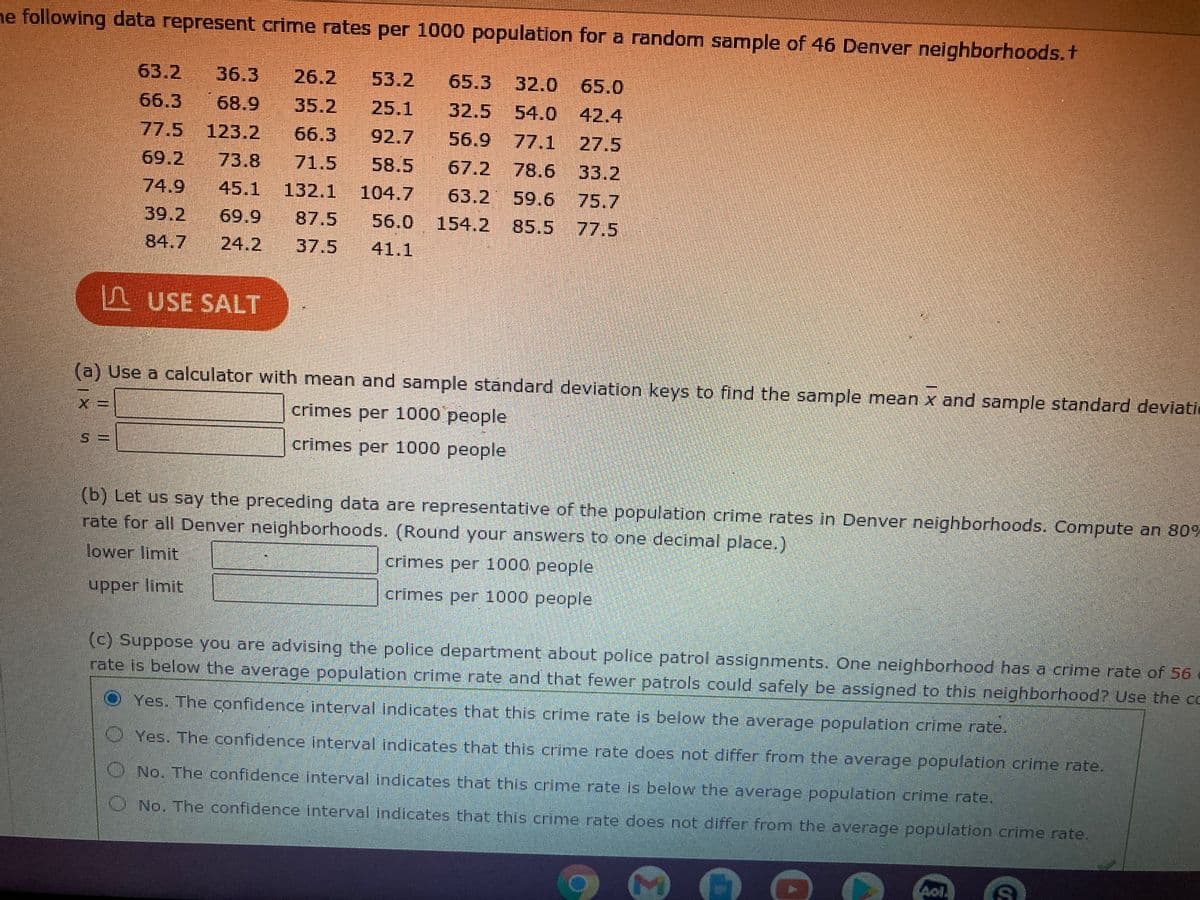ollowing data represent crime rates per 1000 population for a random sample of 46 Denver neighborhoods.t 63.2 36.3 26.2 53.2 65.3 32.0 65.0 66.3 68.9 35.2 25.1 32.5 54.0 42.4 77.5 123.2 66.3 92.7 56.9 77.1 27.5 69.2 73.8 71.5 58.5 67.2 78.6 33.2 74.9 45.1 132.1 104.7 63.2 59.6 75.7 39.2 69.9 87.5 56.0 154.2 85.5 77.5 84.7 24.2 37.5 41.1 A USE SALT (a) Use a calculator with mean and sample standard deviation keys to find the sample mean x and sample standard de crimes per 1000 people S = crimes per 1000 people
ollowing data represent crime rates per 1000 population for a random sample of 46 Denver neighborhoods.t 63.2 36.3 26.2 53.2 65.3 32.0 65.0 66.3 68.9 35.2 25.1 32.5 54.0 42.4 77.5 123.2 66.3 92.7 56.9 77.1 27.5 69.2 73.8 71.5 58.5 67.2 78.6 33.2 74.9 45.1 132.1 104.7 63.2 59.6 75.7 39.2 69.9 87.5 56.0 154.2 85.5 77.5 84.7 24.2 37.5 41.1 A USE SALT (a) Use a calculator with mean and sample standard deviation keys to find the sample mean x and sample standard de crimes per 1000 people S = crimes per 1000 people
Glencoe Algebra 1, Student Edition, 9780079039897, 0079039898, 2018
18th Edition
ISBN:9780079039897
Author:Carter
Publisher:Carter
Chapter10: Statistics
Section10.4: Distributions Of Data
Problem 19PFA
Related questions
Question

Transcribed Image Text:ne following data represent crime rates per 1000 population for a random sample of 46 Denver neighborhoods.t
63.2
36.3
26.2
53.2
65.3
32.0 65.0
54.0 42.4
56.9 77.1 27.5
78.6 33.2
59.6 75.7
68.9
77.5 123.2
66.3
35.2
25.1
32.5
66.3
92.7
69.2
73.8
71.5
58.5
67.2
74.9
45.1
132.1 104.7
63.2
56.0 154.2 85.5
39.2
69.9
87.5
フ7.5
84.7
24.2
37.5
41.1
S USE SALT
(a) Use a calculator with mean and sample standard deviation keys to find the sample mean x and sample standard deviatic
crimes per 1000 people
crimes per 1000 people
(b) Let us say the preceding data are representative of the population crime rates in Denver neighborhoods. Compute an 80%
rate for all Denver neighborhoods. (Round your answers to one decimal place.)
lower limit
crimes per 1000 people
upper limit
crimes per 1000 people
(c) Suppose you are advising the police department about police patrol assignments. One neighborhood has a crime rate of 56
rate is below the average population crime rate and that fewer patrols could safely be assigned to this neighborhood? Use the co
O Yes. The confidence interval indicates that this crime rate is below the average population crime rate.
Yes. The confidence interval indicates that this crime rate does not differ from the average population crime rate.
No. The confidence interval indicates that this crime rate is below the average population crime rate.
O No. The confidence interval indicates that this crime rate does not differ from the average population crime rate.
Aol.
Expert Solution
This question has been solved!
Explore an expertly crafted, step-by-step solution for a thorough understanding of key concepts.
Step by step
Solved in 2 steps with 2 images

Knowledge Booster
Learn more about
Need a deep-dive on the concept behind this application? Look no further. Learn more about this topic, statistics and related others by exploring similar questions and additional content below.Recommended textbooks for you

Glencoe Algebra 1, Student Edition, 9780079039897…
Algebra
ISBN:
9780079039897
Author:
Carter
Publisher:
McGraw Hill

Glencoe Algebra 1, Student Edition, 9780079039897…
Algebra
ISBN:
9780079039897
Author:
Carter
Publisher:
McGraw Hill